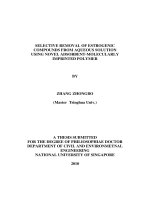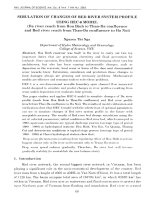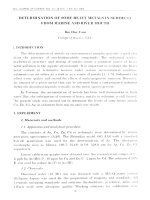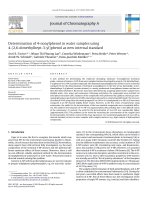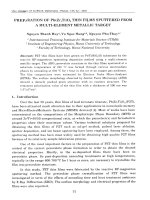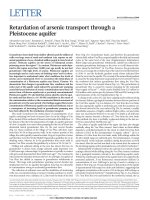DSpace at VNU: Removal of arsenic (V) from aqueous medium using manganese oxide coated lignocellulose silica adsorbents
Bạn đang xem bản rút gọn của tài liệu. Xem và tải ngay bản đầy đủ của tài liệu tại đây (831.77 KB, 22 trang )
Toxicological & Environmental Chemistry
ISSN: 0277-2248 (Print) 1029-0486 (Online) Journal homepage: />
Removal of arsenic (V) from aqueous medium
using manganese oxide-coated lignocellulose/
silica adsorbents
Igor W. K. Ouédraogo, Erol Pehlivan, Hien T. Tran, Samuel Paré, Yvonne L.
Bonzi-Coulibaly, Dieter Zachmann & Müfit Bahadir
To cite this article: Igor W. K. Ouédraogo, Erol Pehlivan, Hien T. Tran, Samuel Paré, Yvonne
L. Bonzi-Coulibaly, Dieter Zachmann & Müfit Bahadir (2015): Removal of arsenic (V) from
aqueous medium using manganese oxide-coated lignocellulose/silica adsorbents, Toxicological
& Environmental Chemistry, DOI: 10.1080/02772248.2015.1133815
To link to this article: />
Accepted author version posted online: 28
Dec 2015.
Submit your article to this journal
Article views: 11
View related articles
View Crossmark data
Full Terms & Conditions of access and use can be found at
/>Download by: [University of California, San Diego]
Date: 12 January 2016, At: 23:47
Igor W. K. Ouédraogo et al., 17/07/2015
Publisher: Taylor & Francis
Journal: Toxicological & Environmental Chemistry
DOI: />
Removal of arsenic (V) from aqueous medium using manganese oxide-coated
lignocellulose/silica adsorbents
Igor W. K. Ouédraogo1*, Erol Pehlivan2, Hien T. Tran3, Samuel Paré4, Yvonne L. BonziDownloaded by [University of California, San Diego] at 23:47 12 January 2016
Coulibaly4, Dieter Zachmann5 and Müfit Bahadir5
1
Biomass Energy and Biofuels Laboratory, International Institute for Water and
Environmental Engineering (2iE), 01 BP 594, Ouagadougou 01, Burkina Faso
2
Department of Chemical Engineering, Selcuk University, Campus, 42031 Konya, Turkey
3
Hanoi University of Science, Hanoi, Vietnam
4
Laboratoire de Chimie Analytique, Environnementale et Bio-Organique, UFR-SEA,
Université de Ouagadougou, 03 BP 7021, Ouagadougou 03, Burkina Faso
5
Institute of Ecological Chemistry and Waste Analysis, Technical University of
Braunschweig, Hagenring 30, 38106 Braunschweig, Germany
Abstract:
Arsenic (V) adsorption on manganese oxide-coated rice wastes was investigated in this study. The
modified adsorbents were characterized by Fourier-transform infrared spectroscopy, scanning
electron microscopy and pH measurements to determine the point of zero charge. Batch adsorption
equilibrium experiments were conducted to study the effects of pH, contact time and initial
concentration on arsenic removal efficiency. The adsorption capacity of rice waste was significantly
improved after modification with permanganate. The Langmuir isotherm model fitted the equilibrium
data better than the Freundlich model which confirms surface homogeneity of the adsorbent.
Maxima adsorption capacities are determined as 10 and 12 mg/g at pH 3 for manganese oxide-coated
rice husk and straw respectively. The adsorption energy indicates that the adsorption process may
be dominated by chemisorption. Pseudo‒second‒order rate equation described the kinetics sorption
of arsenic with good correlation coefficients, better than a pseudo‒first‒order equation. Manganese
oxide-coated rice husk and straw appear to be promising low cost adsorbents for removing arsenic
from water.
Keywords: Lignocellulose/silica adsorbent, Manganese oxide, Arsenic, Adsorption, Rice
waste
* Corresponding author. Tel.: +226 25 30 70 64/ fax: +226 25 30 72 42. ;
E-mail addresses: (I. W. K. Ouédraogo).
1
Igor W. K. Ouédraogo et al., 17/07/2015
I. Introduction
The presence of arsenic (As) in ground and surface waters at elevated concentrations
creates serious problems to human’s health and other organisms (Wu et al. 1989).
Anthropogenic or biological activities, as geochemical conditions may entail the
mobilization of As into groundwater (Malik et al. 2009), and natural processes such as
soil erosion, mineral leaching and weathering are responsible of introducing As into
surface waters. Mining activities, combustion of fossil fuels, and the use of As additives to
Downloaded by [University of California, San Diego] at 23:47 12 January 2016
livestock feed may entail additional impacts (Mohan, Charles, and Pittman 2007).
High concentrations of As in groundwater were reported from Argentina, Austria,
Bangladesh, Chile, China, Ghana, India, Italy, Japan, Malaysia, Mexico, Monogolia, Nepal,
Poland, South Africa, Taiwan, Vietnam, and some parts of the United States (Malik et al.
2009; Mohan, Charles, and Pittman 2007). Smedley, Knudsen, and Maiga (2007) investigated
As concentrations in groundwater in the area of the city of Ouahigouya, located in the North
of Burkina Faso. Most of them had As concentrations ranging between 0.5 and 1630 μg/L.
Other studies in Essakane (Barro-Traoré et al., 2008) showed As concentrations of 13‒212
μg/L in human urine and 69‒101 μg/L in drinking water; while an As concentration of 10
μg/L is recommended by the World Health Organization as guideline value for drinking
water. The presence of As in streams and lakes at elevated concentrations may lead to
bioaccumulation in living organisms, potentially causing health problems to plants, animals,
and humans. Chronic human intake of As has been associated with increased risk of skin,
liver and lung cancer, diabetes, developmental and reproductive problems, and cardiovascular
diseases (Wu et al. 1989).
Co-precipitation, liquid–liquid extraction, ion-exchange, ultrafiltration and reverse osmosis
process have been so far used to remove As from aqueous media (Biswas et al. 2008). Most
of them are cost-intensive and have disadvantages such as incomplete removal, require high
energy, and may generate toxic sludge or waste products which are difficult to dispose
(Choonga et al. 2007). Adsorption is considered to be one of the most promising technologies
because it is low cost and easy to set up (Malik et al. 2009). Removal of As from drinking
water using low cost sorbents, simple and appropriate methods is highly desirable. Rice husk
(RH) and straw (RS) are two of the most abundant lignocellulose and silica waste materials in
the world, with 155.7 million hectares of land cultivated in 2008 (USDA 2009). These
natural materials are considered to be economic precursors for the production of
adsorbents that are extensively used for many purposes of separation and purification
2
Igor W. K. Ouédraogo et al., 17/07/2015
techniques (Sharma et al. 2014). However, the adsorption capacities of lignocellulose for As
removal are low and slow (Al Rmalli et al. 2005; Asif and Chen 2015; Haque et al. 2007;
Ranjan, Talat, and Hasan 2009; Shafique et al. 2012). Therefore, chemical modifications have
been often used to synthesize appropriated and efficient adsorbents for As ions removal
(Anirudhan et al. 2012; Ouédraogo et al. 2015).
Manganese oxides is a subject of interest in various fields including molecular adsorption due
to their outstanding structural multiformity combined with novel chemical and physical
properties. In addition to their ability to remove a wide range of ions from wastewater
Downloaded by [University of California, San Diego] at 23:47 12 January 2016
(Mandal and Suzuki 2002), manganese oxides have various advantages such as low cost, ecofriendliness and abundance as well as their excellent electrochemical properties
(Subramanian, Zhu, and Wei 2008). However, the particle nanosizes agglomerate in
contact with aqueous system. To overcome this difficulty, the nanoparticles were
functionalized by organic, inorganic and composite materials which provide chemical stability
and better distribution of manganese oxides in aqueous system. A recent investigation shows
that various manganese oxides sorbents can be prepared through a simple method by KMnO4
reduction (Subramanian, Zhu, and Wei 2008). Some of the reported modifications used
natural clinoptilolite zeolite (Camacho, Parra, and Deng 2011), bentonite (Eren, Afsin, and
Onal 2009), polystyrene resin (Lenoble et al. 2004) and cellulose fiber (Maliyekkal, Lisha,
and Pradeep 2010; Wang et al. 2014) by forming manganese oxides on the surface, which
improves the metal adsorption capacity. Though limited reports are available on cellulose
as a support for metal oxide nanoparticles, to the best of our knowledge, no studies have
been reported on the synthesis of manganese oxide-coated rice waste fiber and its
application as an adsorbent for As removal.
This work is related to the preparation and evaluation of hybrid organic-inorganic manganese
oxide-coated RH and RS adsorbents, which mainly consist of hemicelluloses, cellulose,
lignins and silica, for removal of As(V) from aqueous solutions. Adsorbents were
characterized with Fourier transform infrared (FTIR) spectroscopy, scanning electron
microscopy (SEM), and pH measurements to determine the point of zero charge (pHpzc).
As(V) adsorption on the adsorbents was investigated through different parameters effects :
pH, contact time and initial concentration.
2. Materials and methods
2.1. Chemicals
All reagents used in this work were of analytical-grade purity. A stock solution (1000 mg/L)
of arsenate was purchased from Merck (Darmstadt, Germany). Diluted standard solutions of
3
Igor W. K. Ouédraogo et al., 17/07/2015
As(V) were prepared daily before use. NH4OH and HCl, purchased from Merck, were used to
adjust the pH of solutions. KI used for reduction of As(V) to As(III) was obtained from Roth
(Karlsruhe, Germany). KMnO4 used for RH and RS modification was purchased from
Fluka (Taufkirchen, Germany). NaBH4 (Fluka), NaOH (Merck) and HCl (Merck) were
used for hydride generation. All glassware and plastic bottles were cleaned with 10% HNO3
(Merck) solution and rinsed with deionized water. Whatman cellulose acetate membrane
(0.2 μm pore size), used for As(V) solution filtration, was purchased from Sigma-Aldrich
(Taufkirchen, Germany). Water was purified using a Seralpur purification system
Downloaded by [University of California, San Diego] at 23:47 12 January 2016
Pro90CN (Ransbach-Baumbach, Germany).
2.2. Modification of RH and RS
RH and RS used in this work were collected from local rice fields in Burkina Faso. The dried
materials were powdered in a ball mill (BLB Braunschweig, Germany) and sieved with a
sieve shaker machine (Retsch, Haan, Germany). The fractions size of 0.063‒0.125 mm
were washed several times with pure water to remove dust and fines, and dried in an oven at
60°C for 24 h. The adsorbents were prepared by impregnation method: 200 mL of an
aqueous solution of KMnO4 (0.1 mol/L) and 5 g of RH or RS were mixed in a 500 mL flask
under continuous stirring. After 5 h, the suspension was filtered. The formation of manganese
oxide on the matrix is shown by the change of the adsorbents’ color from golden brown to
brownish black. The manganese oxide-coated RH (MOCRH) and RS (MOCRS) were
thoroughly washed with deionized water. Samples were dried in an oven at 50°C for 24
h and stored in a desiccator.
2.3. Adsorbent characterization
The functional groups present in RS and MOCRS were characterized by FTIR (BX II, Perkin
Elmer, Waltham, USA) using the KBr pellet method. The spectra were recorded from 4000
to 500 cm‒1 for 5 scans. The pHpzc of adsorbents was determined by the following procedure.
A definite amount, i.e. 0.2 g of sample was added to 50 mL of deionized water at 22±2°C.
Next, the initial pH (pHi) values of the solution were adjusted roughly from pH 5 to 10 by
adding 0.1 mol/L of HCl or NH4OH. After a shaking time of 4 h, the top solution was filtered
and the final pH (pHf) value of the filtrate was measured (Ouédraogo et al. 2015). The
difference between pHi and pHf values (ΔpH = pHf‒pHi) was plotted versus the pHi. The
pHpzc of the sorbent was determined from the point of intersection of the resulting curve, at
4
Igor W. K. Ouédraogo et al., 17/07/2015
which ΔpH = 0. The surface morphology of samples was characterized using a microscope
(JEOL JSM‒6480, Tokyo, Japan). The surface area was characterized from N2 adsorption–
desorption isotherms at ‒196°C obtained using an adsorption instrument (Micromeritics
ASAP 2020, Georgia, USA). The specific surface areas were assessed using the BET
(Brunauer–Emmett–Teller) equation. Thermal degradation characteristics were carried out
with a thermogravimetric analyzer (SETSYS Evolution TGA 16/18, Setaram
Instrumentation, Caluire-et-Cuire, France). The ramping rate was 10°C/min up to 900°C
using N2 as the carrier gas. The results were reported in percentage weight (TG) and
Downloaded by [University of California, San Diego] at 23:47 12 January 2016
differential weight (dTG) versus temperature. Sample ash contents have been determined
using NF MO3-003/ EN 14775 / ISO 1171 standard method. Ashes were digested with
37% HCl and the manganese contents were determined by atomic absorption
spectrometry (AAS).
2.4. Batch sorption experiments
Batch experiments were carried out in plastic bottles (50 mL) by adding 0.2 g sorbent to 50 mL of
aqueous As(V) solution. The initial pH of the solution was adjusted to between 2 -10 by adding 0.1
mol/L HCl or NH OH solution. The plastic bottles were gently agitated in an electric shaker
4
(Guwina-Hofmann, Berlin, Germany) at 150 rpm for 4 h. The sorbent was removed by filtration
with cellulose acetate membrane and the remaining As was determined. The influence of contact
time was studied at pH 3 for 0.25 to 6 h and for initial concentrations of 2 to 150 mg/L. All
experiments were performed in triplicates and the average values were taken.
Maximum
deviation was <5%.
2.5. Analysis of As in aqueous system
A hydride generation atomic absorption spectrometry with a Zeeman correction (HGAASHitachi Z-2000 AAS, Tokyo, Japan) was used to determine As concentrations. Arsine
obtained from As(III) gives the best signal at a concentration range from 1‒20 μg/L;
therefore, all As(V) in the sample should be previously reduced to As(III) and diluted with
3% HCl solution. The reduction was carried out with the optimized protocol: 2.5 mL of 30%
HCl and 2.5 mL of 20% KI solutions were added to 10 mL of all samples. One hour later,
the volume was adjusted to 25 mL with 3% HCl solution before analysis. For hydride
generation, the following solutions were used: (i) 3.7% HCl; (ii) NaBH4–NaOH solution: 10
g of NaBH4 in 1 L of deionized water by adding 4 g of NaOH.
5
Igor W. K. Ouédraogo et al., 17/07/2015
3. Results and discussion
3.1. Adsorbent characterization
Infrared spectroscopy was used to study the interaction of the metal oxide with the
lignocellulosic support. Fig. 1 shows the FTIR spectra of both RS (a) and MOCRS (b). The
peak located at around 3350 cm−1 is attributed to O–H stretching vibration. The band located
at 1420 cm−1 can be assigned to the CH2 scissoring motion. The spectra indicated weak peak
near 1730 cm−1 corresponding to C=O stretching from carbonyl group. The band at 1620 and
Downloaded by [University of California, San Diego] at 23:47 12 January 2016
1462 cm−1 can be assigned to C=C aromatic skeletal vibration. The characteristic band at
around 1060 cm-1 corresponding to C–O–C stretching is also observed in both spectra. The
features of these bands are typical to lignocellulosic material. The band at 802 cm−1 was
assigned to symmetric Si–O–Si stretching vibration (Shahrokh Abadi et al. 2015). The
bending vibration for H–O–H was observed at 1638 cm−1 (Ma, Deng, and Yao 2014). The
MOCRS spectrum shows some changes mainly in the decrease of the ratio of COOH (1741
cm−1) group's intensity, which can be explained by the complexation of Mn ions with
carboxylate group in the matrix. A new band appears at 569 cm−1 that was attributed to the
stretching vibration of Mn–O (Maliyekkal, Lisha, and Pradeep 2010; Wang et al. 2014). The
peak at 3350 cm‒1 became broad, suggesting a strong interaction between the OH groups
of cellulose and manganese oxide (Ma, Deng, and Yao 2014).
The structure and the morphology of RS and MOCRS are showed by SEM images in Fig. 2.
Table 1 summarizes the characteristics properties of the samples. Both RS and MOCRS have
relatively uniform surface, where roughness could be seen. Comparing the SEM images, RS
shows a significantly wrinkled surface than MOCRS. The color of fibers changes from golden
brown to brownish black suggesting the formation of MnO2 phase on the RS (Shaabani,
Hezarkhani, and Shaabani 2014; Wang et al. 2014). Actually, KMnO4 reacts with cellulose
to form cellulose–nanoscale manganese oxide composite (Maliyekkal, Lisha, and Pradeep
2010). The synthesis of MOCRS composite was based on the reduction and precipitation of
manganese oxide, which resulted in a homogeneous distribution of manganese oxide particles
in the lignocellulose matrix. It was also found that ash and total manganese content in the RS
and MOCRS were increased from 16 to 44.63% and 0.11 to 16.96%, respectively. This high
percentage of residual ash in MOCRS is assumed to be from manganese–lignocellulose
complex. Moreover, the surface area of RS is slightly increased through KMnO4
treatment.
6
Igor W. K. Ouédraogo et al., 17/07/2015
TG and dTG curves of RS and MOCRS are presented in Fig. 3. A minor weight loss ~1.5%
was first observed around 160°C in the RS, which may be due to water and the
decomposition of volatile matters such as low molecular weight sugars. Following this, a
weight loss by approximately ~50% occurred from 220 to 400°C, which is hemicellulose
and cellulose decomposition (Wattanasiriwech, Wattanasiriwech, and Svasti 2010). The dTG
peaks are respectively 322 and 366°C. Another important loss of ~14% due to the
decomposition of lignin occurred between 350 and 600°C. The results show that the
thermal stability of RS moves to lower temperatures by modification with manganese. A
Downloaded by [University of California, San Diego] at 23:47 12 January 2016
weight loss by approximately 40% took place from 120 to 500°C, which should be attributed
to the decomposition of hemicelluloses, cellulose and lignins. The corresponding dTG
peaks are respectively at 200, 293 and 394°C. The percentage weight loss of the residue
after heating up to 900°C was ~20% higher for MOCRS (57.25%) when compared to RS
(38.26%). This result indicates the presence of manganese in MOCRS. As shown in Fig.
4, the pHpzc of MOCRS is ~7.6, close to the value found with manganese oxide-coated resin
(7.8) (Lenoble et al. 2004). This reveals that the adsorbent had a basic nature, as pHpzc is
higher than 7.
3.2. As (V) removal experiments
It is well known that the pH is an important parameter in the adsorption process. The charge
of the adsorbate and the adsorbent often depends on the pH of the solution due to H+ ions
exchange. The results (Fig. 5) show that As(V) adsorption by MOCRS occurs at pH
below the pHpzc. Optimum removal of As(V) by MOCRS was achieved at initial pH 3 with
the removal of more than 60% of the As(V). In the pH range of 3–6, the adsorbent surface is
positively charged, which is appropriated to adsorb the major H2AsO4– species present in
aqueous medium. Under high basic conditions, i.e. pH of 8–10, As adsorption by MOCRS
was minimal, with a removal of 3% at pH 10. The decrease in As adsorption with the increase
in pH is due to the increase in the negative charge density on the adsorbent surface, and to the
increase in the number of OH‒ ions in the solution, in competition with HAsO42– species.
The kinetic adsorption study was carried out with 50 mg/L As(V) solution. The uptake
equilibrium was achieved after 3 h and no noticeable changes were observed for longer
reaction times. The experimental data of As(V) on MOCRS were analyzed by using pseudofirst-order and pseudo-second-order kinetic models (Han et al. 2013). The rate constants K1,
K2, the calculated adsorption capacities qe(cal) values and the corresponding linear regression
correlation coefficients R2 were summarized in Table 2. Rate constants were 0.011 min‒1 for
7
Igor W. K. Ouédraogo et al., 17/07/2015
first-order expression and 0.042 g/mg/min for second-order. The maxima adsorption
capacities, calculated by first- and second-order models were respectively ~1.0 and 7.8 mg/g.
The data showed that the R2 value of pseudo-second-order model is more than 0.99,
while the corresponding value of pseudo-first order model is less than 0.97. More
importantly, the qe(cal) obtained with the pseudo-second kinetic model, are in agreement with
experimental adsorption capacity qe(exp).
The effect of As(V) concentration on the sorption by the MOCRH and MOCRS were
investigated and Fig. 6 shows the equilibrium adsorption capacity qe (mg/g) versus As(V)
Downloaded by [University of California, San Diego] at 23:47 12 January 2016
concentrations Ce (mg/L) at equilibrium. The sorption of As ions with both sorbents increased
with the increasing of ions concentration.
Characterization of the adsorption process is often carried out using a number of isotherm
models. These include the most common Langmuir, Freundlich and Dubinin–Radushkevich
(D–R) isotherms (Han et al. 2013). Langmuir model has been the most often used empirical
model, since it contains the two useful and easily imaginable parameters, i.e. the affinity of
binding sites or bonding energy b and the monolayer sorption saturation capacity Qmax.
Freundlich model is an exponential equation that describes two physical parameters, i.e.
the adsorption capacity Kf and the intensity of adsorption 1/n. Table 3 gives an overview
of Langmuir and Freundlich constants for MOCRH and MOCRS. It was found that the R2
values of Langmuir (> 0.98) model were higher than those obtained from the linear form of
Freundlich (≤ 0.98). This result indicates that Langmuir type sorption isotherm is suitable for
equilibrium studies. Therefore, the adsorption of As(V) ions onto MOCRS and MOCRH is
considered forming a monolayer that takes place at the binding sites on the sorbent surface.
The maximum adsorption capacity, at pH 3, for MOCRS (12.0 mg/g) was found to be higher
than for MOCRH (10.2 mg/g). Manganese oxide content in the adsorbent is a key factor
which might influence As adsorption. It was reported that metal oxide amount in RS
composite is higher than RH composite (Ouédraogo et al. 2015). RH consists of hard
materials, including silica and lignin, and has a more recalcitrant cell wall structure than RS,
which has lower lignin content (Boonmee 2012). A wide range of low-cost sorbents has been
studied worldwide for As(V) removal. The values reported in this study are several times
higher than those of unmodified biomass adsorbents, e.g., sorghum biomass (Haque et al.
2007), hyacinth root (Al Rmalli et al. 2005), rice husk (Asif and Chen 2015) and rice polish
(Ranjan, Talat, and Hasan 2009) and at least three times higher than pine leaves (Shafique et
al. 2012). Moreover, it was also found that As(V) adsorption by MOCRS (~70 mg As(V)/g of
Mn present in the adsorbent) is higher than the micro-/nano-structured MnO2 (~23 mg
8
Igor W. K. Ouédraogo et al., 17/07/2015
As(V)/g of Mn) (Zhang and Sun 2013). This is due to a well distribution of manganese
oxide in the lignocellulosic matrix, which leads to a better surface contact. Furthermore,
As speciation combined with the different pHzpc values highlighted these differences.
In addition, adsorption data were further analyzed using D–R model. The general form of the
D–R equation model is:
ln qe = ln Xm − βå2
(1)
9 = RT ln (1 + 1/Ce)
(2)
Downloaded by [University of California, San Diego] at 23:47 12 January 2016
where
where qe is the amount of As ions adsorbed per unit weight of sorbent (mol/g), and Ce is the
concentrations at equilibrium (mol/L). Xm is the maximum adsorption capacity (mol/g), β is
the activity coefficient (mol2/kJ2) related to sorption mean free energy (kJ/mol) and 9 is the
Polanyi potential, where R (8.32 J/mol/K) is the gas constant and T (K) is the absolute
temperature. The results of parameters obtained from the model are listed in Table 3. The D–
R isotherm model showed higher R2 value (≥ 0.99) than those obtained for Langmuir and
Freundlich. The maximum adsorption capacity Xm of both MOCRH and MOCRS calculated
from Eq. (1) were 0.00032 mol/g (23.975 mg/g) and 0.00038 mol/g (28.470 mg/g),
respectively. The mean adsorption energy (E) could be estimated from the β value (Table 3)
using the following equation:
E = (‒2β)‒0.5
(3)
The E values was calculated to be 12.5 kJ/mol for As(V) on both MOCRS and MOCRH
adsorbents, which ranges between 8 and 16 kJ/mol, implying chemical adsorption by ligand
exchange.
3. Conclusion
The availability of the natural materials, their simple modification without pretreatment, and
the relative good adsorption capacity of As(V) levels make the prepared MOCRH and
MOCRS materials suitable for potential practical applications. In a future study, the
correlation between the amount of manganese coated adsorbents and the As adsorption
performance will be investigated.
9
Igor W. K. Ouédraogo et al., 17/07/2015
Acknowledgement
This investigation was performed at the Guest Chair within the project “Exceed - Excellence
Center for Development Cooperation - Sustainable Water Management in Developing
Countries” at the Technische Universitaet Braunschweig; Prof. Dr. Pehlivan being the visiting
professor, and Ms. Tran and Dr. Ouédraogo being the international exchange staff members.
The Exceed Project is granted by the German Federal Ministry for Economic Cooperation and
Development (BMZ) and German Academic Exchange Service (DAAD); we gratefully
Downloaded by [University of California, San Diego] at 23:47 12 January 2016
acknowledge their financial support.
10
Igor W. K. Ouédraogo et al., 17/07/2015
References
Al Rmalli, S. W., C. F. Harrington, M. Ayub, and P. I. Haris. 2005. A biomaterial based
approach for arsenic removal from water. Journal of Environmental Monitoring 7: 279–282.
DOI: 10.1039/B500932D.
Anirudhan, T. S., J. Nima, S. Sandeep, and V. R. N. Ratheesh. 2012. Development of an
amino functionalized glycidyl methacrylate-grafted-titanium dioxide densified cellulose for
Downloaded by [University of California, San Diego] at 23:47 12 January 2016
the adsorptive removal of arsenic(V) from aqueous solutions. Chemical Engineering Journal
209: 362–371.
DOI:10.1016/j.cej.2012.07.129.
Asif Z., Z. Chen. 2015. Removal of Arsenic from drinking water by using Rice Husk. Applied
Water Science.
DOI 10.1007/s13201-015-0323-x.
Barro-Traoré, F., S. R. M. Tiendrébéogo, S. Lallogo, S. Tiendrébéogo, M. Dabal, and H.
Ouédraogo. 2008. Cutaneous manifestations of arsenicisme in Burkina-Faso: Epidemiological
and clinical features. Mali Medical 23: 7‒11.
URL: />Biswas, B. K., J-I. Inoue, K. Inoue, K. N. Ghimire, H. Harada, K. Ohto, and H. Kawakita.
2008. Adsorptive removal of As(V) and As(III) from water by a Zr(IV)-loaded orange waste
gel. Journal of Hazardous Material 154: 1066–1074.
DOI:10.1016/j.jhazmat.2007.11.030.
Boonmee, A. 2012. Hydrolysis of various Thai agricultural biomasses using the crude enzyme
from Aspergillus Aculeatus IIZUKA FR60 isolated from soil. Brazilian Journal of
Microbiology 43: 456–466.
DOI: 10.1590/S1517-83822012000200005.
Camacho, L. M., R. R. Parra, and S. Deng. 2011. Arsenic removal from groundwater by
MnO2-modified natural clinoptilolite zeolite: Effects of pH and initial feed concentration.
Journal of Hazardous Materials 189: 286–293.
11
Igor W. K. Ouédraogo et al., 17/07/2015
DOI:10.1016/j.jhazmat.2011.02.035.
Choonga, T. S. Y., T. G. Chuaha, Y. Robiah, F. L. Gregory Koaya, and I. Azni. 2007. Arsenic
toxicity, health hazards and removal techniques from water: An overview. Desalination 217:
139–166.
DOI:10.1016/j.desal.2007.01.015.
Eren, E., B. Afsin, and Y. Onal. 2009. Removal of lead ions by acid activated and manganese
Downloaded by [University of California, San Diego] at 23:47 12 January 2016
oxide-coated bentonite. Journal of Hazardous Materials 161: 677–685.
DOI:10.1016/j.jhazmat.2008.04.020.
Han, C., H. Li, H. Pu, H. Yu, L. Deng, S. Huang, and Y. Luo. 2013. Synthesis and
characterization of mesoporous alumina and their performances for removing arsenic(V).
Chemical Engineering Journal 217: 1–9.
DOI:10.1016/j.cej.2012.11.087.
Haque, M. N., G. M. Morrison, G. Perrusquıa, M. Gutierréz, A. F. Aguilera, I. Cano-Aguilera,
and J. L. Gardea-Torresdey. 2007. Characteristics of arsenic adsorption to sorghum biomass.
Journal of Hazardous Materials 145: 30–35.
DOI:10.1016/j.jhazmat.2006.10.080.
Lenoble, V., C. Laclautre, B. Serpaud, V. Deluchat, and J-C. Bollinger. 2004. As(V) retention
and As(III) simultaneous oxidation and removal on a MnO2-loaded polystyrene resin. Science
of The Total Environment 326: 197–207. DOI:10.1016/j.scitotenv.2003.12.012.
Ma, M-G., F. Deng, and K. Yao. 2014. Manganese-containing cellulose nanocomposites: The
restrain effect of cellulose treated with NaOH/urea aqueous solutions. Carbohydrate Polymers
111: 230–235. DOI:10.1016/j.carbpol.2014.04.080.
Malik, H., Z. M. Khan, Q. Mahmood, S. Nasreen, and Z. A. Bhatti. 2009. Perspectives of low
cost arsenic remediation of drinking water in Pakistan and other countries. Journal of
Hazardous Material 168: 1–12. DOI:10.1016/j.jhazmat.2009.02.031.
12
Igor W. K. Ouédraogo et al., 17/07/2015
Maliyekkal, S. M., K. P. Lisha, and T. Pradeep. 2010. A novel cellulose–manganese oxide
hybrid material by in situ soft chemical synthesis and its application for the removal of Pb(II)
from water. Journal of Hazardous Materials 181: 986–995.
DOI:10.1016/j.jhazmat.2010.05.112.
Mandal, K., and K. T. Suzuki. 2002. Arsenic round the world: a review. Talanta 58: 201–
235. DOI:10.1016/S0039-9140(02)00268-0.
Downloaded by [University of California, San Diego] at 23:47 12 January 2016
Mohan, D., U. Charles, and Jr. Pittman. 2007. Arsenic removal from water/wastewater using
adsorbents
–
A
critical
review.
Journal
of
Hazardous
Materials
142:
1–53.
DOI:10.1016/j.jhazmat.2007.01.006.
Ouédraogo, W. K. I., E. Pehlivan, H. Tran, Y. L. Bonzi-Coulibaly, D. Zachmann, and M.
Bahadir. 2015. Synthesis of iron oxyhydroxide-coated rice straw (IOC-RS) and its application
in arsenic(V) removal from water. Journal of Water and Health 13: 726–736.
DOI: 10.2166/wh.2015.242.
Ranjan, D., M. Talat, and S. H. Hasan. 2009. Biosorption of arsenic from aqueous solution
using agricultural residue ‘rice polish’. Journal of Hazardous Materials 166: 1050–1059.
DOI:10.1016/j.jhazmat.2008.12.013.
Shaabani, A., Z. Hezarkhani, and S. Shaabani. 2014. Cellulose supported manganese dioxide
nanosheets catalyzed aerobic oxidation of organic compounds. RSC Advances 4: 64419–
64428. DOI: 10.1039/C4RA11101J.
Shafique, U., A. Ijaz, M. Salman, W. uz Zaman, N. Jamil, R. Rehman, and A. Javaid. 2012.
Removal of arsenic from water using pine leaves. Journal of the Taiwan Institute of Chemical
Engineers 43: 256–263. DOI:10.1016/j.jtice.2011.10.006.
Shahrokh Abadi, M. H., A. Delbari, Z. Fakoor, and J. Baedi. 2015. Effects of annealing
temperature on infrared spectra of SiO2 extracted from rice husk. Journal of Ceramic Science
and Technology 06: 41–46.
DOI: 10.4416/JCST2014-00028.
13
Igor W. K. Ouédraogo et al., 17/07/2015
Sharma, G., M. Naushad, D. Pathania, A. Mittal and G.E. El-desoky. 2014. Modification of
Hibiscus cannabinus fiber by graft copolymerization: application for dye removal.
Desalination and Water Treatment 54:3114–3121. DOI: 10.1080/19443994.2014.904822.
Smedley, P. L., J. Knudsen, and D. Maiga. 2007. Arsenic in groundwater from mineralised
proterozoic basement rocks of Burkina Faso. Applied Geochemistry 22:1074–1092.
DOI:10.1016/j.apgeochem.2007.01.001.
Downloaded by [University of California, San Diego] at 23:47 12 January 2016
Subramanian, V., H. Zhu, and B. Wei. 2008. Alcohol-assisted room temperature synthesis of
different nanostructured manganese oxides and their pseudocapacitance properties in neutral
electrolyte. Chemical and Physics Letters 453: 242–249. DOI:10.1016/j.cplett.2008.01.042.
USDA. 2009. Rice Production, Area and Yield. IRRI World Rice Statistics (WRS).
URL: />Wang, Y., X. Zhang, X. He, W. Zhang, X. Zhang, and C. Lu. 2014. In situ synthesis of MnO2
coated cellulose nanofibers hybrid for effective removal of methylene blue. Carbohydrate
Polymers 110: 302–308. DOI: 10.1016/j.carbpol.2014.04.008.
Wattanasiriwech, S., D. Wattanasiriwech, and J. Svasti. 2010. Production of amorphous silica
nanoparticles from rice straw with microbial hydrolysis pretreatment. Journal of NonCrystalline Solids 356: 1228–1232. DOI:10.1016/j.jnoncrysol.2010.04.032.
Wu, M. M., T. L. Kuo, Y. H. Hwang, and C. J. Chen. 1989. Dose response relation between
arsenic concentration in well water and mortality from cancers and vascular diseases.
American Journal of Epidemiology 130: 1123–1132.
URL: />Zhang, T., and D. D. Sun. 2013. Removal of arsenic from water using multifunctional micro/nano-structured MnO2 spheres and microfiltration. Chemical Engineering Journal 225: 271–
279. DOI:10.1016/j.cej.2013.04.001.
14
Downloaded by [University of California, San Diego] at 23:47 12 January 2016
Igor W. K. Ouédraogo et al., 17/07/2015
Fig. 1. FTIR spectra of samples: (a) RS, and (b) MOCRS
15
Igor W. K. Ouédraogo et al., 17/07/2015
Downloaded by [University of California, San Diego] at 23:47 12 January 2016
a
b
Fig. 2. SEM micrograph of sample: (a) RS, and (b) MOCRS
16
Downloaded by [University of California, San Diego] at 23:47 12 January 2016
Igor W. K. Ouédraogo et al., 17/07/2015
Fig. 3. TG and dTG thermograms of RS and MOCRS
17
Downloaded by [University of California, San Diego] at 23:47 12 January 2016
Igor W. K. Ouédraogo et al., 17/07/2015
Fig. 4. Plot of ∆pH against pHi of MOCRS. Experimental conditions: sorbent amount = 4 g/L,
ultrapure water pH range = 5‒10, shaking time = 4 h, temperature = 22±2 °C.
18
Downloaded by [University of California, San Diego] at 23:47 12 January 2016
Igor W. K. Ouédraogo et al., 17/07/2015
Fig. 5. Plot of As(V) ion uptake (%) against pH onto MOCRS. Experimental conditions:
initial arsenate concentration = 50 mg/L, sorbent amount = 4 g/L, pH range = 2‒10, shaking
time = 4 h, temperature = 22±2 °C.
19
Downloaded by [University of California, San Diego] at 23:47 12 January 2016
Igor W. K. Ouédraogo et al., 17/07/2015
Fig. 6. Sorption isotherm of As(V) ion onto MOCRH and MOCRS as a function of initial
concentration. Experimental conditions: initial arsenate concentration range = 2–150 mg/L,
pH = 3, sorbent amount = 4 g/L, shaking time = 3 h, temperature = 22±2 °C.
20
Igor W. K. Ouédraogo et al., 17/07/2015
Table 1:
Characteristics of RS and MOCRS
Properties
RS
MOCRS
golden brown
brownish black
BET Surface area (m /g)
2.85
7.83
Ash content (%)
16.00
44.63
Manganese total (%)
0.11
16.96
‒
~7.60
Color
Downloaded by [University of California, San Diego] at 23:47 12 January 2016
2
pHzpc
Table 2:
Kinetic parameters obtained from pseudo-first-order and pseudo-second-order for As(V) sorption onto MOCRS.
pH
Pseudo-first-order model
qe (exp)
(mg/g)
3
7.78
Pseudo-second-order model
K1
(min−1)
qe(cal)
(mg/g)
R2
K2
(g/mg/min)
qe(cal)
(mg/g)
R2
0.011
0.99
0.9687
0.042
7.85
0.9999
Table 3:
Freundlich, Langmuir and D–R characteristic constants for As(V) adsorption onto adsorbents.
Adsorbents
Freundlich isotherm model
2
Langmuir isotherm model
β
(mol2/kJ2)
R2
E
(kJ/mol)
0.987
0.00032
‒ 0.0032
0.990
12.5
0.985
0.00038
‒ 0.0032
0.997
12.5
1/n
R
b
(L/mg)
Qmax
(mg/g)
R
MOCRH
2.00
0.385
0.966
0.16
10.16
MOCRS
2.26
0.400
0.980
0.16
12.03
21
D–R isotherm model
Xm
(mol/g)
Kf
(mg/g)(L/mg)n
2
